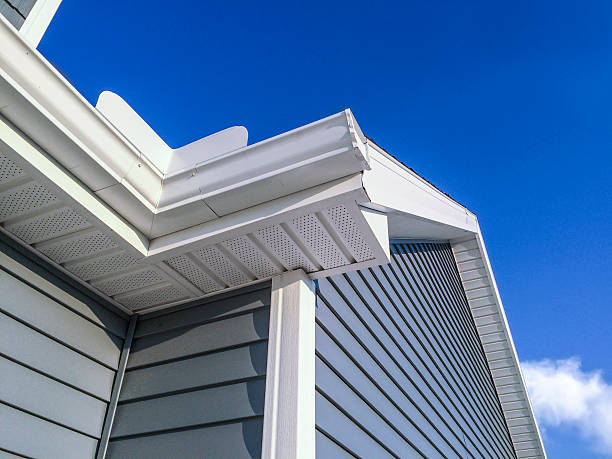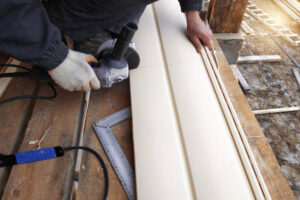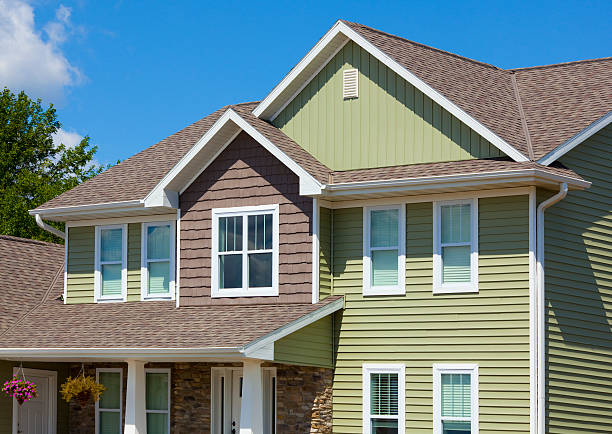How many years should siding last?

The lifespan of siding can vary depending on several factors such as the type of material used, the quality of installation, the climate, and the level of maintenance. Here is a general idea of how long different siding materials typically last:
Aluminum Siding
Aluminum siding is a lightweight and durable option that is resistant to rust and corrosion. With proper care, aluminum siding can last up to 40 years.
Average Lifespan Of Siding: How To Ensure Your Siding Lasts To The Utmost
The average lifespan of siding depends on several factors such as the type of siding, the quality of the installation, and the climate of the area where the siding is installed. Here are some tips to ensure that your siding lasts to the utmost:
Choose high-quality siding
Investing in high-quality siding can make a big difference in how long it lasts. Be sure to research and select a siding material that is durable, weather-resistant, and appropriate for your climate.
Proper installation
Proper installation is key to ensuring your siding lasts. Hire an experienced and qualified contractor who will install your siding correctly, including proper insulation, flashing, and sealing to prevent water damage.
Regular maintenance
Regular maintenance can help extend the lifespan of your siding. This includes cleaning the siding periodically, inspecting it for damage, and repairing any issues promptly.
Be mindful of weather conditions
Extreme weather conditions such as high winds, hailstorms, and heavy rain can cause damage to siding. Be mindful of these conditions and take any necessary precautions to protect your siding.
Address any issues promptly
If you notice any issues with your siding, such as cracks, warping, or fading, address them promptly. Waiting too long to repair or replace damaged siding can lead to more significant problems down the line.
By following these tips, you can help ensure that your siding lasts to the utmost, providing protection and aesthetic appeal for your home for years to come.
When to Repair Versus When to Replace Siding
Deciding whether to repair or replace your siding can depend on several factors, including the extent of the damage, the age of the siding, and your budget. Here are some things to consider when making this decision:
Extent of damage
If the damage to your siding is limited to a small area, such as a few cracks or holes, it may be possible to repair it rather than replace it. However, if the damage is widespread or affects the structural integrity of the siding, replacement may be necessary.
Age of the siding
If your siding is nearing the end of its lifespan or has already exceeded it, replacement may be the better option. Old siding can become brittle and prone to cracking or breaking, and it may no longer provide adequate protection against the elements.
Energy efficiency
If your home is poorly insulated, replacing your siding with a more energy-efficient material can help to reduce your heating and cooling costs. Newer siding materials, such as vinyl or fiber cement, can provide better insulation than older materials like wood or aluminum.
Aesthetics
If you’re looking to update the look of your home, replacing your siding can be a good option. Newer materials and styles can give your home a fresh, modern look that can increase its curb appeal.
Budget
Repairing damaged siding is generally less expensive than replacing it. However, if your siding is old or in poor condition, replacement may be a better long-term investment, as it can improve the value and energy efficiency of your home.
Ultimately, the decision to repair or replace your siding will depend on your specific situation. It’s important to consult with a professional siding contractor who can evaluate the condition of your siding and recommend the best course of action.
Replace Vinyl Siding

Vinyl siding is a durable and long-lasting material, but it will eventually wear out and need to be replaced. Here are some signs that it may be time to replace your vinyl siding. If you notice any of these signs, it may be time to consider replacing your vinyl siding. A professional siding contractor can assess the condition of your siding and recommend the best course of action.
Fading or discoloration
Over time, vinyl siding can fade or become discolored due to exposure to the sun, weather, and other environmental factors. If your siding looks dull or discolored, it may be time to replace it.
Warping or buckling
If your siding is warped or buckling, it can indicate that it is no longer properly attached to your home or that it has become too brittle to maintain its shape.
Increased energy bills
If your home’s energy bills have been steadily increasing, it may be a sign that your vinyl siding is no longer providing adequate insulation. This can occur if the siding has become damaged or if it was not installed properly.
Water damage
If you notice water stains or damage inside your home, it may be a sign that your siding is allowing moisture to seep in. This can occur if the siding has become damaged or if it was not installed properly.
Painting On Siding Peeling Off
If the painting on your siding is peeling off, it’s likely due to one or more of the following reasons:
- Poor Surface Preparation: The siding may not have been properly cleaned, sanded, or primed before the paint was applied. If the surface is dirty, greasy, or rough, the paint won’t adhere properly and will eventually peel off.
- Moisture: Moisture can seep into the siding and cause the paint to peel. This is especially common in areas with high humidity or frequent rainfall. Moisture can also seep into the siding from the inside of the house, causing the paint to peel from the backside.
- Sun Exposure: Siding that is exposed to direct sunlight for long periods of time can cause the paint to fade and peel.
To fix the peeling paint on your siding, you should:
- Remove the loose paint using a scraper or wire brush. Be careful not to damage the underlying siding.
- Clean the surface thoroughly with soap and water, and rinse well.
- Sand the surface lightly to create a smooth surface.
- Apply a primer to the surface to help the new paint adhere better.
- Apply a new coat of paint to the surface, using high-quality paint and a paintbrush or roller.
- Allow the paint to dry completely before touching or painting over it.
Consider applying a protective coating or sealer to help prevent future peeling.
It’s also important to address any underlying issues that may have caused the paint to peel in the first place, such as moisture or sun exposure. Fixing these issues can help ensure that the new paint job lasts longer.
Evidence of Holes And Cracks On Siding
There are several signs that you may have holes or cracks in your siding, including:
- Visible holes or cracks: You may be able to see holes or cracks in your siding if you look closely. These may appear as small punctures or larger gaps in the material.
- Water damage: If water is seeping into your home from the outside, you may notice water damage on your siding, such as discoloration or warping.
- Pest infestations: Holes in your siding can provide an entry point for pests such as rodents and insects, so if you have noticed an increase in pest activity around your home, this could be a sign of siding damage.
- Increased energy bills: Cracks or holes in your siding can allow air to escape from your home, causing your heating and cooling systems to work harder and increasing your energy bills.
If you suspect that your siding has holes or cracks, it’s important to have it inspected by a professional as soon as possible. Damage to your siding can lead to further damage to your home, and it’s often easier and less expensive to fix the problem sooner rather than later.

Bending And Folding Out Of Shape
Siding, like any other building material, can be subject to bending and folding out of shape due to various factors, such as weather conditions, age, or improper installation. Here are some common reasons why siding may bend or fold out of shape:
- Thermal expansion and contraction: Siding materials expand and contract as they heat up and cool down. If the siding is not installed correctly or if the temperature fluctuates too rapidly, it can cause the siding to bend or warp.
- Impact damage: Siding can be damaged by impacts from things like hail, wind-blown debris, or accidental collisions. This can cause the siding to bend or fold out of shape.
- Moisture damage: If water gets behind the siding or the siding is not properly sealed, it can cause the siding to warp and buckle.
- Age and wear: Over time, siding can become brittle and less flexible, making it more susceptible to bending or breaking.
To prevent bending and folding out of the shape of siding, it is important to ensure proper installation, use high-quality materials, and perform regular maintenance and inspections to identify and repair any damage or wear. If you notice any issues with your siding, it is best to contact a professional to assess and address the problem.
The Average Expected Time For Wear & Tear: Is It Avoidable? How?
The average expected time for wear and tear can vary greatly depending on the type of item or equipment in question. However, wear and tear is a natural part of the aging process and is generally unavoidable. That being said, there are steps you can take to prolong the lifespan of your possessions and minimize the effects of wear and tear.
Here are a few tips:
Proper maintenance
Regular maintenance and upkeep can help prevent premature wear and tear. This includes cleaning, lubrication, and any necessary repairs.
Avoid overuse
Overuse can lead to more rapid wear and tear. Be mindful of how often you use your possessions and try to give them a break when possible.
Use as intended
Follow the manufacturer’s instructions for use to avoid unnecessary strain or damage to the item.
Store properly
Proper storage can help protect your possessions from damage and wear and tear. This includes storing them in a dry, cool place, away from direct sunlight or extreme temperatures.
Invest in quality
Higher quality products are often built to last longer and withstand more wear and tear. While they may cost more upfront, they can save you money in the long run by reducing the need for replacements or repairs.
While wear and tear is inevitable, taking these steps can help prolong the lifespan of your possessions and minimize the effects of aging.
Pocket-friendly Siding Replacement Tips
Replacing the siding on your home can be an expensive project, but with a few DIY tips, you can save money and achieve great results. Here are some pocket-friendly DIY siding replacement tips:
- Choose the Right Materials: Selecting the right siding material is key to saving money. Look for cost-effective options like vinyl or fiber cement siding that offer durability and require less maintenance. Additionally, consider buying pre-painted siding to save on painting costs.
- Plan and Measure: Plan ahead and measure the areas where you’ll be installing the new siding. This will help you avoid costly mistakes and minimize waste.
- Rent or Borrow Tools: If you don’t have the necessary tools to complete the project, consider renting or borrowing them from a friend or family member. This will save you the cost of buying new tools.
- Remove Old Siding Carefully: Removing the old siding carefully can save you money on repairs. Take your time to avoid damaging the wall underneath the siding.
- DIY Installation: Installing siding can be a DIY project if you have the right tools and know-how. Follow manufacturer instructions carefully and take your time to ensure a quality installation.
- Get Help When Needed: Don’t hesitate to ask for help from a friend or family member. Having an extra set of hands can make the project easier and faster.
- Maintenance: Regular maintenance can extend the life of your siding, saving you money in the long run. Clean your siding regularly, and inspect it for any damage or signs of wear and tear.
By following these tips, you can save money on your siding replacement project while achieving a professional-looking result.
